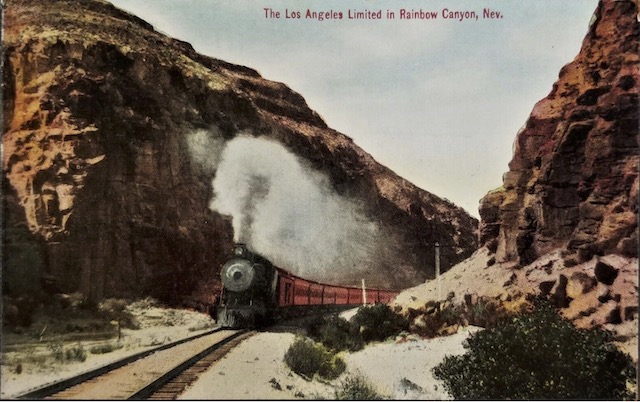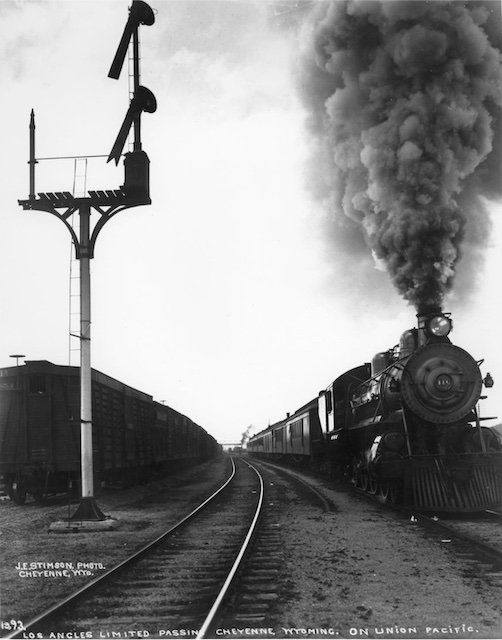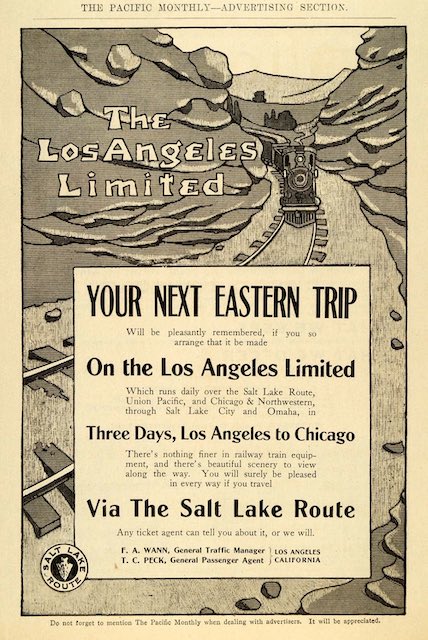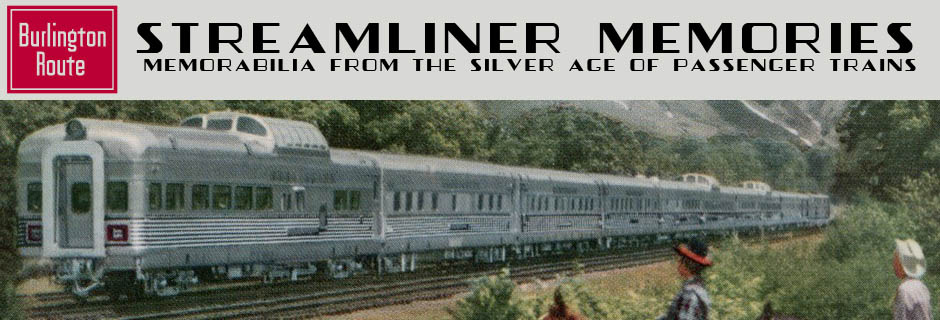In late 1905, a new competitor entered the market for premium Chicago-Los Angeles trains: the Los Angeles Limited. This route was made possible when the San Pedro, Los Angeles and Salt Lake Railroad completed its line between Salt Lake City and Los Angeles on May 26, 1905. The Salt Lake Route, as the railroad styled itself, was half owned by Union Pacific until 1921, when UP bought out the investors who owned the other half.

This postcard, which was mailed in 1912, shows a train of at least nine cars, which is longer than when the Los Angeles Limited began running in 1905. Click image to download a 229-KB PDF of this postcard.
The railroad soon announced that, jointly with Union Pacific and Chicago & North Western, it would offer a first-class, limited train between Chicago and Los Angeles to compete with the California Limited and Golden State Limited. “The train will be electrically lighted throughout and will be composed of standard and tourist sleeping cars, dining cars and observation car, with buffet, smoking, and library apartments,” reported the December 8 issue of Railway Age.
While the above quote uses the plural for “standard and tourist sleeping cars,” in fact the train initially consisted of one each plus the observation car (which had some sleeping berths). From Salt Lake City to Los Angeles, each train had five cars: a baggage car with a dynamo to power the electric lights; a 14-section and drawing room Pullman sleeping car; a tourist sleeping car that probably had 16 sections; a diner; and the observation car.
The latest locomotives in 1905 were 4-6-2 Pacifics, and the Salt Lake Route proudly noted in the Official Guides that the Los Angeles Limited “engines are of the handsome Pacific type.” Twenty-six 4-6-2s had been delivered to the railroad in 1904 by Burnham, Williams (meaning Baldwin). These non-superheated locos had 77″ drivers and produced 29,920 pounds of tractive effort, which was sufficient for a short train.
 This photo was taken by Wyoming photographer Joseph Stimson in 1906. It shows a 4-6-2 Pacific with the same specifications as the Pacific-type locomotives used on the Salt Lake Route. This train has the five cars of the 1905 Los Angeles Limited plus two mail cars. Click image for a larger view.
This photo was taken by Wyoming photographer Joseph Stimson in 1906. It shows a 4-6-2 Pacific with the same specifications as the Pacific-type locomotives used on the Salt Lake Route. This train has the five cars of the 1905 Los Angeles Limited plus two mail cars. Click image for a larger view.
Eight sets of equipment were needed for the train, which was to start running on November 26. However, the inauguration was delayed until December 17 as Pullman was unable to obtain the dynamos on time.
Although Railway Age reported that “The equipment of the train is first class in every respect,” the Los Angeles Limited was not as exclusive as its competitors. In addition to first-class sleeping cars, it included tourist sleepers, which in Europe would have been called second-class as they had less space and fewer amenities per passenger. Moreover, between Chicago and Omaha the C&NW included a “reclining chair car,” so it wasn’t even an all-sleeping-car train, much less an all-first-class train.
 Instead of claiming that the Los Angeles Limited was the poshest train between Chicago and Los Angeles (which it wasn’t), this 1907 ad relies on the soft sell, promising that “your trip will be pleasantly remembered.” Click image for a larger view.
Instead of claiming that the Los Angeles Limited was the poshest train between Chicago and Los Angeles (which it wasn’t), this 1907 ad relies on the soft sell, promising that “your trip will be pleasantly remembered.” Click image for a larger view.
The Salt Lake Route was 2,306 miles, or 39 miles longer than Santa Fe’s route and 28 miles longer than the Golden State route. At 1905 speeds, 39 miles required at least an hour of travel, but the train was scheduled to take approximately the same amount of time as its competitors. A Railway Age reporter on the inaugural run noted that “there was no difficulty experienced in keeping up to schedule. In fact, though no attempt was made at fast running, it became necessary to ‘loaf’ on several occasions.”
Although the press reported that the trains operated on 68-hour or even 66-hour schedules, the railroads soon relaxed their timetables. Before the Los Angeles Limited began running, the January, 1904 Official Guide showed that the California Limited and Golden State Limited took 66 hours eastbound, but 68 hours and 45 minutes (50 minutes in the case of the Golden State) westbound.
The inaugural westbound run of the Los Angeles Limited took 68-3/4 hours. But despite the new competition, all of the railroads had slowed their schedules by December 1906, which is the first Official Guide I have after the LA Limited was inaugurated. At that time, the eastbound California Limited took 66 hours and 5 minutes, but the Los Angeles Limited required 67 hours 10 minutes and the Golden State 68-1/2 hours. Westbound was much slower, with the Santa Fe taking 71 hours 7 minutes, Golden State 71 hours 46 minutes, and Los Angeles Limited 71 hours and 50 minutes.
Part of the reason for this was the Los Angeles still wasn’t considered the main destination for travelers to California. Though rapidly growing, its population would have been only about 200,000 in 1905, while San Francisco’s was nearly twice that. The California Limited and Golden State Limited both had cars that continued from Los Angeles to San Francisco. By 1920, Los Angeles would surpass San Francisco in population and its Mediterranean climate would make it the main tourist destination in California.
Somewhere around the time Los Angeles outnumbered San Francisco, the Los Angeles Limited would become a true first-class train. The 1912 Official Guide shows that it was still carrying tourist sleepers plus a chair car between Chicago and Omaha, but the 1921 Guide says that it was “for first-class sleeping car passengers only.” Unfortunately, I have no timetables or official guides for the intervening years, so I don’t know exactly when this change took place.

Your current series on the emergence of the early heavyweight trains is truly fascinating…the golden age before the streamliners!
Anyhow, as late as May 1916, the Los Angeles Limited still seems to have been something of a hybrid. The ORG from that month mentions that the observation car had “barber and valet service,” but there was still a Pullman Tourist Sleeping Car. No mention of coaches, but a note stipulates that local passengers were handled (with restrictions) to/from various points along the line.
There are a number of additional issues of the ORG (notably from the 1910s onwards) available at the UK site timetableworld.com.